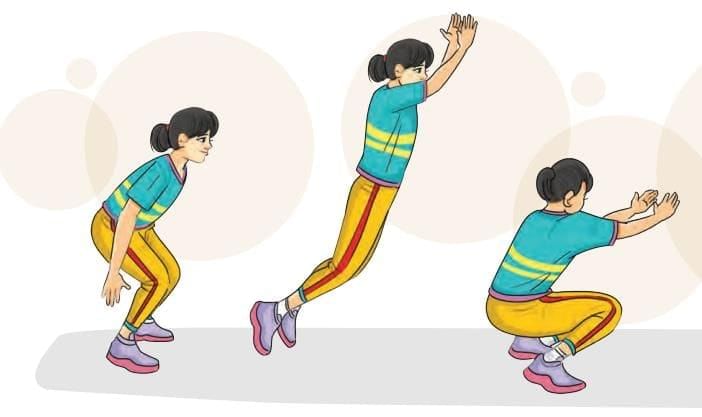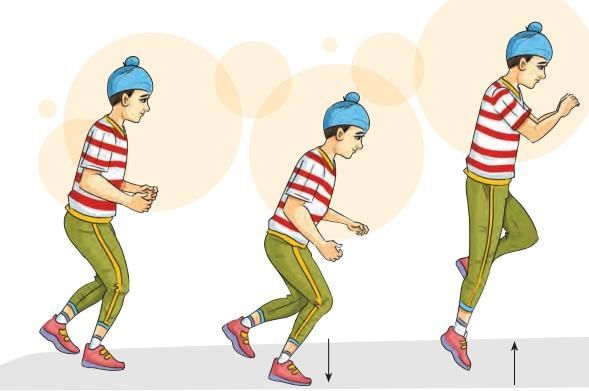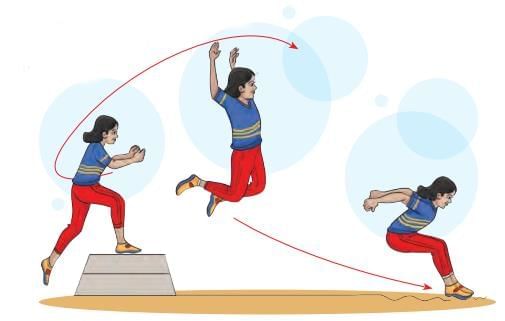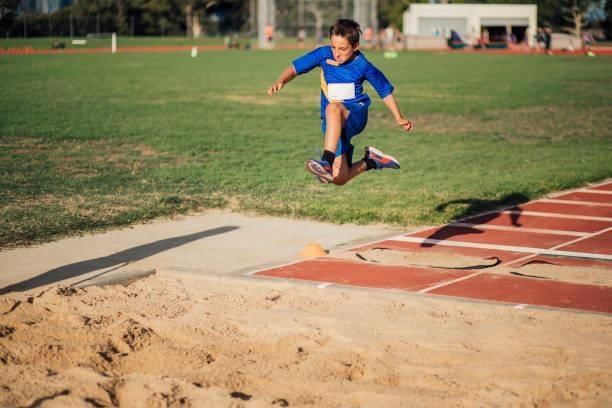Grade 6 Exam > Grade 6 Notes > Physical Education for Grade 6 > Chapter Notes: Fundamental Skills of Sports – Athletics
Fundamental Skills of Sports – Athletics Chapter Notes | Physical Education for Grade 6 PDF Download
| Table of contents |

|
| Introduction |

|
| Crouch or Sitting Start |

|
| Jumping |

|
| Long Jump |

|
| Standing Broad Jump |

|
| Hopping |

|
| Making an Arch |

|
| Landing |

|
| High Jump |

|
| Heading Suspended Ball |

|
| Trikoṇa Kainchī Kūda |

|
| Putting Ball |

|
Introduction
In this chapter, you will learn about the basic and most important athletic skills used in sports. Athletics includes various events like running, jumping, and throwing. These skills help improve our speed, strength, coordination, and overall fitness. Athletics also teaches discipline, teamwork, and determination.
Athletics
- Also called Track and Field.
- Main types of events: Track Events, Field Events, and Combined Events.
- Helps develop strength, speed, agility, endurance, flexibility, and coordination.
- Important for growth of physical and technical skills.
- Encourages willpower, self-discipline, and team spirit.
Running
- A way of moving quickly on foot with both feet leaving the ground.
- Needs good technique, speed, endurance, and coordination.
Techniques to Start the Race
- Crouch or Sitting Start: Used in races up to 400 metres.
- Types of crouch starts:
- Bunch or Bullet start
- Medium start
- Elongated start
- Standing Start: Used in longer races. Not covered in detail here.
Crouch or Sitting Start
 Block Placement and Adjustment
Block Placement and Adjustment
- Blocks placed correctly behind the start line.
- Front block at 1.5 foot length from the line.
1. On Your Marks Position
- Runner gets into position with stronger leg in front block.
- Rear foot pressed against block, rear knee on ground.
- Hands shoulder-width apart, fingers forming a bridge.
- Relaxed head, eyes on ground.
2. Set Position
- Hips lifted, rear leg off the ground.
- Body weight balanced.
- Leg angles: Front knee ~90°, rear knee ~110°–130°.
3. Drive Phase
- Runner explodes from the blocks on "Go".
- Pushes strongly with both legs for speed.
- Arms swing with the legs to help speed.
4. Acceleration Phase
- Body leans forward after start.
- Stride gets longer and faster.
- Good lean gives better acceleration.
5. Finish Phase
- Maintain top speed till the finish line.
- Lean forward slightly to finish faster.
- Finishing Techniques:
- Run Through
- Lunge
- Shoulder Shrug
Jumping

- Act of propelling body into the air using legs.
- Main goal: jump high or far.
Phases of Jumping
- Approach Run: Controlled running to gain momentum.
- Take-off: Push from ground with proper body position.
- Flight: Staying balanced in the air.
- Landing: Bend knees to absorb impact and avoid foul.
Long Jump
1. Approach Phase
- Beginners: 10 strides, Experts: over 20 strides.
- Speed increases gradually till take-off.
- Strides must be consistent.
2. Take-off Phase
- Quick foot plant with down-back motion.
- Minimal knee bend, full leg extension.
- Pushes up while keeping forward speed.
3. Flight Phase
- Maintain balance in the air.
- Two techniques taught: Sail and Hang.
- Sail: Legs stretched forward, trunk upright.
- Hang: Arms/legs go back, then forward, hips pushed forward.
4. Landing Phase
- Legs extended, trunk forward, arms pulled back.
- Land on feet, avoid falling backward.
Standing Broad Jump

- 5 players jump one by one, each from where the last one landed.
- Total distance of all jumps is measured.
- Team with longest distance wins.
Hopping

- Jump on one leg for 15 metres, then switch legs and return.
- Compare hopping barefoot vs with shoes.
Making an Arch

- Place a block a few steps ahead.
- Step on it with strong foot, jump in a backward arch.
- Repeat 10 times.
Landing
- Jump off from the take-off board into the pit.
- Stretch legs forward, lean body forward, and bend arms.
High Jump
1. Approach Phase
- J-shaped run: Straight part (3–6 steps), then curve (4–5 steps).
- Increases speed, lowers body slightly before take-off.
2. Take-off Phase
- Quick, flat foot plant with ‘down and back’ motion.
- Free leg goes up, body becomes upright.
3. Flight Phase
- Technique taught: Straddle.
- Jumper clears bar facing downward.
- Leading leg then trailing leg crosses the bar.
4. Landing Phase
- Land on back and shoulders, knees apart.
Heading Suspended Ball
- Hang balls at different heights.
- Run and hit each ball with head.
- Move to higher balls after each try.
Trikoṇa Kainchī Kūda
- Create triangle track (points A, B, C - 10m apart).
- Run from A to B: Jump on and off boxes.
- B to C: Jump over cones and hurdle.
- C to A: Sprint back quickly.
Putting Ball
- Stand behind lines 15m apart.
- Hold ball near neck and throw with leg push and chest lift.
- Partners throw the ball back and forth.
The document Fundamental Skills of Sports – Athletics Chapter Notes | Physical Education for Grade 6 is a part of the Grade 6 Course Physical Education for Grade 6.
All you need of Grade 6 at this link: Grade 6
|
16 docs|4 tests
|
FAQs on Fundamental Skills of Sports – Athletics Chapter Notes - Physical Education for Grade 6
| 1. What are the key differences between a crouch start and a sitting start in athletics? |  |
Ans. The crouch start involves an athlete positioning themselves on the starting line with one foot forward and the other back, using their hands on the ground for balance. This position allows for a powerful push-off when the race begins. In contrast, the sitting start has the athlete seated on the ground, typically with their legs extended, and they must push off and rise before running. The crouch start is generally more common in sprints, while the sitting start may be used in events where the athlete begins from a stable position.
| 2. How is the standing broad jump executed, and what are its key components? |  |
Ans. The standing broad jump requires an athlete to begin from a stationary position, typically with feet shoulder-width apart. The athlete bends their knees and swings their arms back to gather momentum. Upon jumping, they extend their legs forward and land on both feet. Key components include proper technique in bending the knees, swinging the arms for momentum, and achieving maximum distance by landing effectively.
| 3. What are the main techniques for performing a high jump? |  |
Ans. The main techniques for performing a high jump include the approach run, take-off, and clearance over the bar. The athlete typically uses a curved run-up to gain speed and momentum. During take-off, they must jump off one foot while initiating a body rotation to clear the bar. The Fosbury Flop is a popular technique where the athlete goes over the bar back-first, allowing for higher jumps. Proper technique in each phase is crucial for maximizing height and success in the jump.
| 4. Why is landing technique important in jumping events, and what should athletes focus on? |  |
Ans. Landing technique is crucial in jumping events to prevent injuries and ensure a safe return to the ground. Athletes should focus on bending their knees upon landing to absorb the impact, keeping their feet shoulder-width apart for stability, and maintaining a balanced posture. Proper landing techniques can help in reducing the risk of injuries, particularly to the knees and ankles, and allow for a smoother transition back into running or other movements after the jump.
| 5. What are the benefits of practicing hopping in athletic training? |  |
Ans. Practicing hopping offers several benefits in athletic training, including improved leg strength, balance, and coordination. Hopping helps develop the muscles used in jumping, which enhances overall performance in various athletic events. It also promotes agility and stability, which are essential for many sports. Regular hopping drills can improve an athlete’s explosive power and contribute to better performance in long jump and high jump events.
Related Searches




















